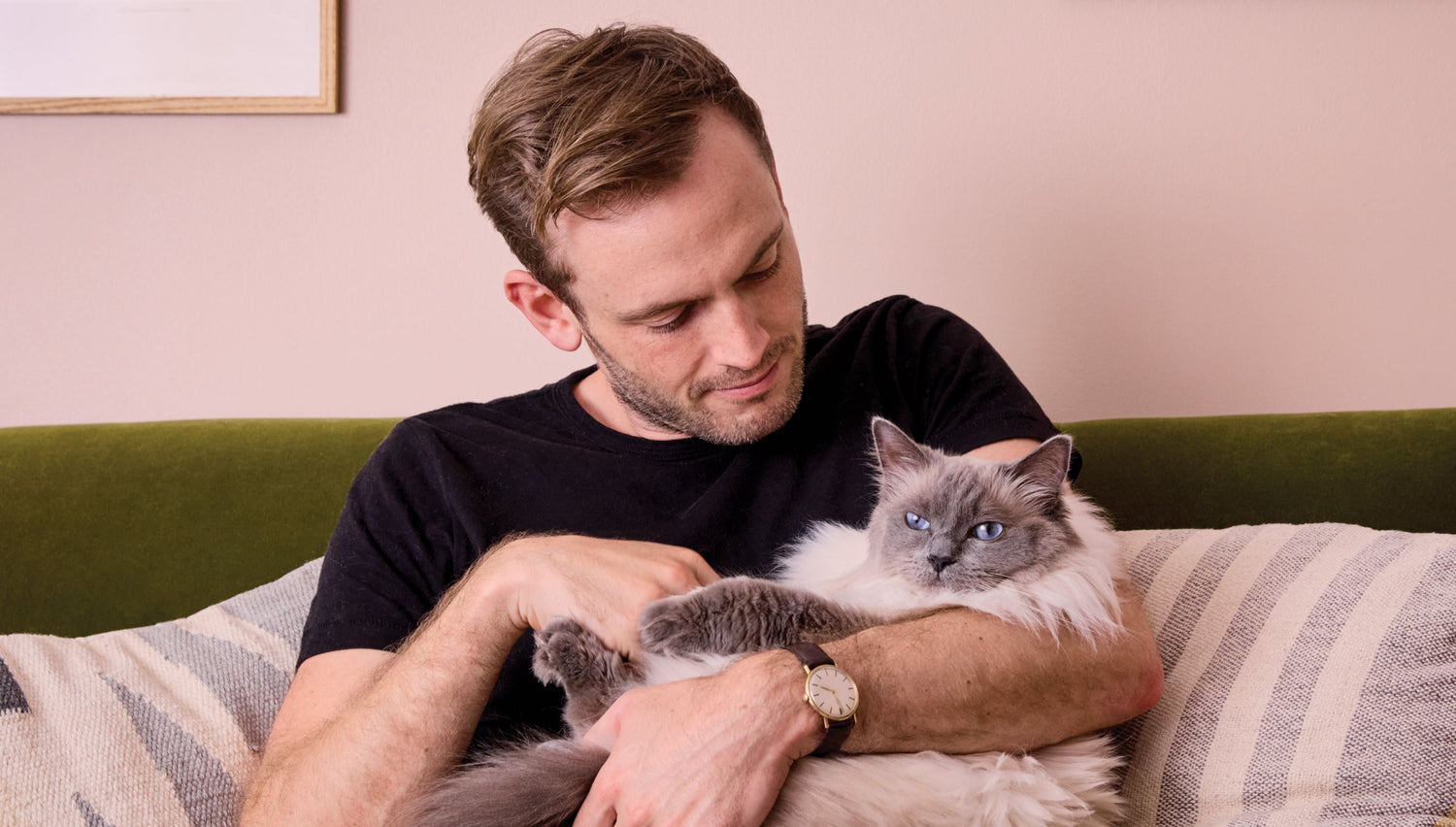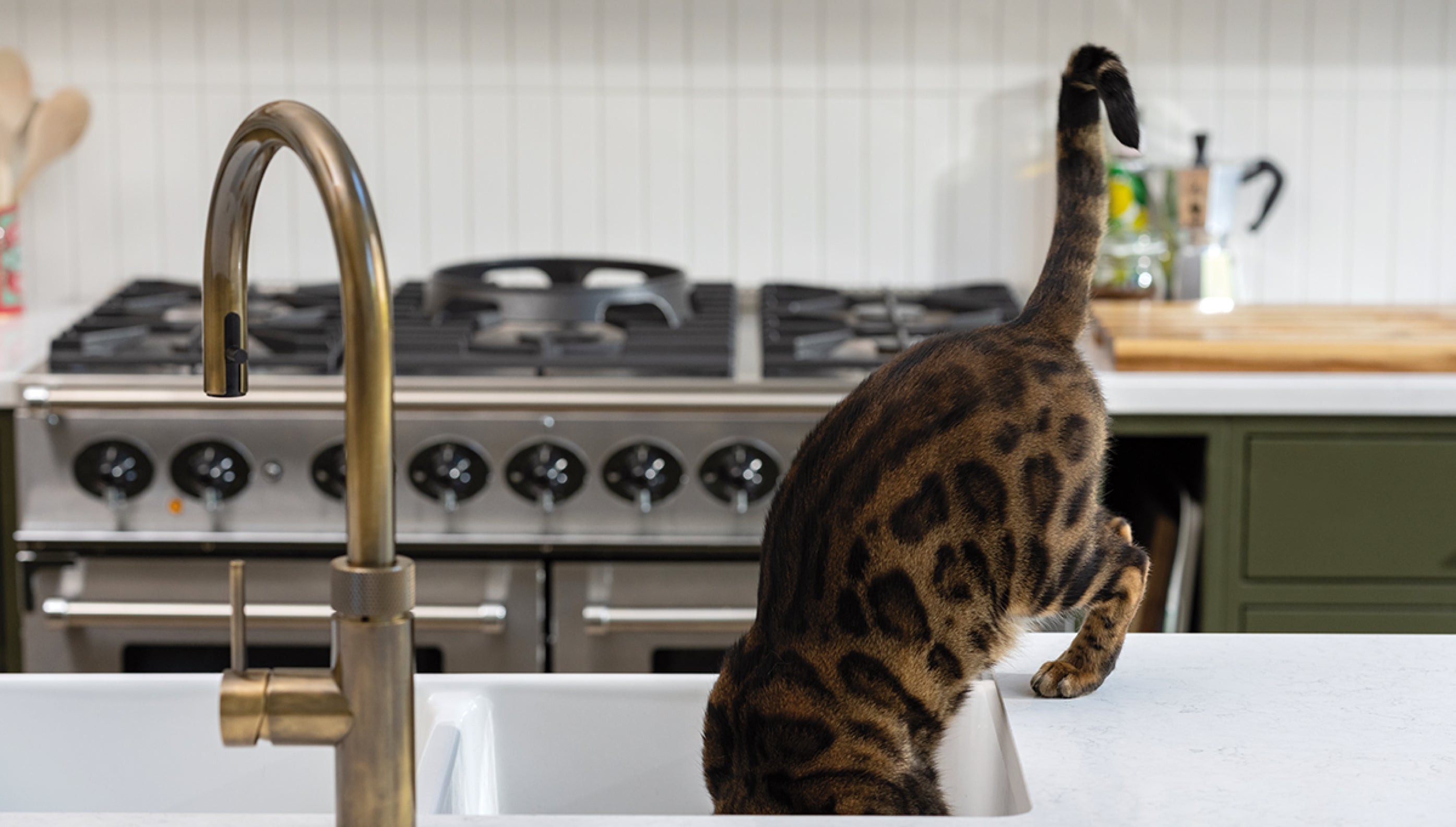We asked pet expert Rory the Vet for his advice.
So, you’ve decided to adopt a cat or kitten? Congratulations! Welcoming a new pet into your family is a big decision, but with so many cats out there looking for a home, you’ll receive boundless love and rewards in return. But before you pick up your new furry companion, there are a few important details you will need to consider in order to make everything go as smoothly as possible. The following advice applies to all new cat parents, whether they have adopted or not. Let’s get down to it.
MEET RORY THE VET

We’ve partnered up with animal whisperer and renowned veterinarian, Dr Rory Cowlam, to share his wisdom when it comes to all things furry. And boy, does this man know his stuff.
Starting with his degree from the Royal Veterinary College, Rory has since co-starred in the CBBC’s series The Pet Factor, shared his knowledge on the likes of Blue Peter and written all about it in his book, Secret Life of a Vet.
Follow him on Instagram
The most important things to do when adopting a cat
• Set up a safe space for your cat to help them settle into your home
• Scent swapping is an effective way to help your cat get used to their new environment
• Give your cat time to adjust and let them explore at their own pace
• I generally don’t advise letting a new cat out for at least 2-4 weeks
• Keep as much the same as possible, such as food, litter and blankets, to try and provide some familiarity and comfort
How cats can react to adoption
As you can imagine, coming into a new environment can be stressful or scary for cats. New smells, new faces, new noises. Your cat may want to hide away in the beginning. Or they may be the opposite—excited, curious and taking everything in their stride. It’s entirely dependent on the cat. But for most, it often takes a number of weeks for them to settle into a new home. Sometimes even months.
It’s important you remain patient during the whole process, especially in the first few hours. Try not to pressure your new kitty into doing anything they may not be ready for. Be gentle and keep noise to a minimum. Make sure to have a private, cosy spot ready for your cat in case they need any alone time - having their own space can help them feel safe while they process their new surroundings. And keep an eye out on their eating and loo habits. If they are going either secretly (only at night, when alone), or going to the loo in odd places, then this can suggest that they are still settling. If this continues over time, consult your vet.
IT CAN TAKE A NUMBER OF WEEKS FOR CATS TO SETTLE – SOMETIMES MONTHS!
What to consider before adopting a cat?
As exciting as it is to introduce a furry bundle of joy into your life, it also requires a lot of responsibility and thought. All potential cat parents should consider the following before making any moves to adopt.
- Cats can live up to 20 years and cost a lot of money in food, vet bills, pet insurance and other costs over that time. Make sure you are ready to cover these costs in order to keep your cat healthy and happy.
- Personally, I am pro-adoption - there are so many unwanted cats out there in rescues and adopting can be a profoundly rewarding experience
- Cats can live up to 20 years and cost a lot of money in food, vet bills, pet insurance and other costs over that time. Make sure you are ready to cover these costs in order to keep your cat healthy and happy.

Understand the financial and lifestyle implications
As mentioned, understanding the financial necessities that come from owning a cat is vital to preparing your new life with your kitty. For reference, Battersea Dogs and Cats Homing Shelter state that the typical annual cost for one cat is around £1500 per year. Below are some of their estimations of factors that can contribute to this.
Vet bills—minimum £50 a year for vaccinations, fleas, worming and an annual vet check. This will likely be more for cats with medical needs
- Microchip—£20-30 one off expense
- Insurance—£24 per month
- Food—£20-55 per month
- Litter—£20-30 per month
- Toys—£40 one off expense
- Grooming tools—£10 one off expense
- Cat bed—£20 one off expense
- Cat carrier—£25 one off expense
Learn about your cat’s needs before you adopt
So you’ve spotted a cute cat. Now what? This is your chance to learn all about their personality to ensure you’re their right fit. Speak to the shelter and ask them what kind of home and owner your cat would best be paired with. Prepare a list of questions including those that relate to your lifestyle. This should include everything from what specific food the cat enjoys and its grooming needs to whether it is an indoor or outdoor cat, if it is dog-friendly, etc. After all, it doesn’t matter how cute they are, if your home isn’t right for them, then it’s probably not going to work.
I would also recommend reading up on cat care beforehand. Beyond this article, the icatcare website is a helpful guide when it comes to any questions or concerns that you may have.

Help your cat get familiar with you before you take them home
At this stage you should know that your personalities are a good match. Now it’s important you start building a trusting relationship with your soon-to-be best bud. A good way to do this is to visit your cat at the shelter multiple times before taking them with you. That way they can become familiar with your touch, voice and, in particular, smell. Cats are reliant on scent. To help them get used to your scent, take a blanket from home and leave it with your pet a few days before you collect them.
Make your cat carrier comfortable
There are a couple of ways you can make that journey home easier.
- Make sure you choose a carrier that is strong, secure and easy to clean
- That blanket just mentioned? Place it in the carrier with your cat to help them feel less stressed
- Pheromone sprays are helpful for cats who are extremely nervous. Spray at least 15 minutes before your cat enters the carrier
- Make sure you choose a carrier that is strong, secure and easy to clean
Create a safe space for your cat
Earlier, we mentioned creating a private spot for your furry friend. Here's how you can make sure your cat’s new den feels extra safe and cosy.
- Create the spot in a quiet area of your home that’s easily accessible
- Cats like to be up high or in hidey holes which they can see out of but are hidden. Cat perches are great for adult cats who like to climb. A cardboard box with a blanket inside works great too
- Easily accessible food and water—ideally in separate spots
- Easily accessible litter tray placed away from their food
- Include toys for stimulation and comfort
- Calming music can help too!

Open up your home gradually
Your home may feel big and overwhelming at first (especially to tiny furballs!). Opening up each room slowly can help. That way they can explore every corner and smell at their own pace before they move on to the next. Just make sure they always have access to their safe space should they want to be alone. Every cat is different, so be patient and go along with whatever feels best for your feline.
Let your cat outdoors when they’re ready
It’s up to you to decide whether your feline should be an outdoor or indoor cat.
For outdoor cats, I recommend keeping them inside for at least 2-4 weeks before letting them out, and only do so when you feel like your cat seems content in their new home. Make sure that they have been neutered, microchipped and are up to date with their vaccinations beforehand. Try not to feed them for a few hours before letting them explore outside, then use food to encourage them back in.
A checklist for adopting a cat
All of the basic kitty essentials.
- Food and water. In the beginning stages of your cat’s new life, you should keep your cat on the same food they’ve been eating at the adoption shelter. If you want to make a change to their diet later, make sure you do it gradually.
- One food bowl. Either wash daily or have a couple to alternate.
- One water bowl.
- Litter tray. You will need at least one litter tray, left uncovered and far away from the cat’s food and water.
- Cat bed. Soft and cosy, this will need to be placed in a quiet spot.
- Scratching post.
- Brush. This is especially important for long-haired cats.
- Cat toys.
- Cat carrier. One that is sturdy and well ventilated.
- Access to a high spot.
- Vet health check. To make sure your cat is happy and healthy.
- Ongoing treatment against fleas and worms. You can purchase this with your vet who will explain how and when to apply these treatments.
- Neutering. (If old enough!)
- Microchip. (For cats over 12 weeks of age.) Microchipping your cat helps them get found if they ever get lost or stolen.
- Vaccinations.
- Pet insurance.
How to introduce an adopted cat to other pets and children
There will always be an adjustment period in the beginning, but in most cases, this will get better over time. I recommend avoiding introducing your cat to other pets and children for the first few days until they feel more comfortable. Do it gradually over time. With family members, have them greet the cat one by one. It will be less intimidating this way. If you have children, make sure that they are calm and gentle when being introduced. Let the cat come to them and show them how to stroke and interact with the cat, making sure they don’t excitedly pull their tail or push them around.
If introducing your cat to another pet, begin by swapping blankets or beds to share scents. Let them in the same room at different times, so that they can explore and get used to scents. Then allow them to see each other through a window or a stairgate. After that, let them be at either side of a single door so that they can smell each other. Once they seem comfortable with this, you can let them into a large room together. Make sure your cat can escape to their safe space if needed. Don’t be surprised if they seem a little hostile during the first few meetings. This is normal.

What to do if you think your adopted cat is unhappy
Hopefully all of these steps will have contributed to a well-adjusted kitty. But during the first few months of their new life, it is crucial you watch out for any signs that might indicate your cat is not settling in as well as they should. This could be anything from continuing to hide away, not eating, only using the loo at night, and not displaying typical cat behaviours such as playing. Always consult your vet if this continues to happen over an extended period. In the meantime, there are a few methods that can help:.
- Organise a vet check in the first few weeks to identify any problems early on
- Calming music can help tone down stress
- Use pheromone plug ins or sprays
- Groom your cat – if they consent!
Time—it can take some cats more time than others to settle in
How to adjust your cat’s diet
Always make any dietary changes gradually, as sudden changes to the diet can cause tummy upsets. If you are either switching to a different recipe or to a new food, it’s best to introduce it into your cat’s diet low and slow, over about a week. Start with a mix of 4/5 of your current food to 1/5 of the new recipe/food. Day by day, increase the proportions until you’re feeding only the intended recipe. Monitor their weight to make sure you’re feeling the appropriate amount for your cat.

A kitten’s diet and feeding needs are very different from that of an adult cat. They need to be fed a complete diet that has been specially formulated to help them grow. You can check out this helpful guide for more information on how to feed your kitten.
The information in this article is intended as a guide to help pets and pet parents on their journey together. It is provided for educational and informational purposes only and is not meant as a substitute for professional advice from a vet, behaviourist, trainer or other professional. We encourage all pet parents to consult with their vet and/or behaviourist to ensure their pet’s specific needs are met.




